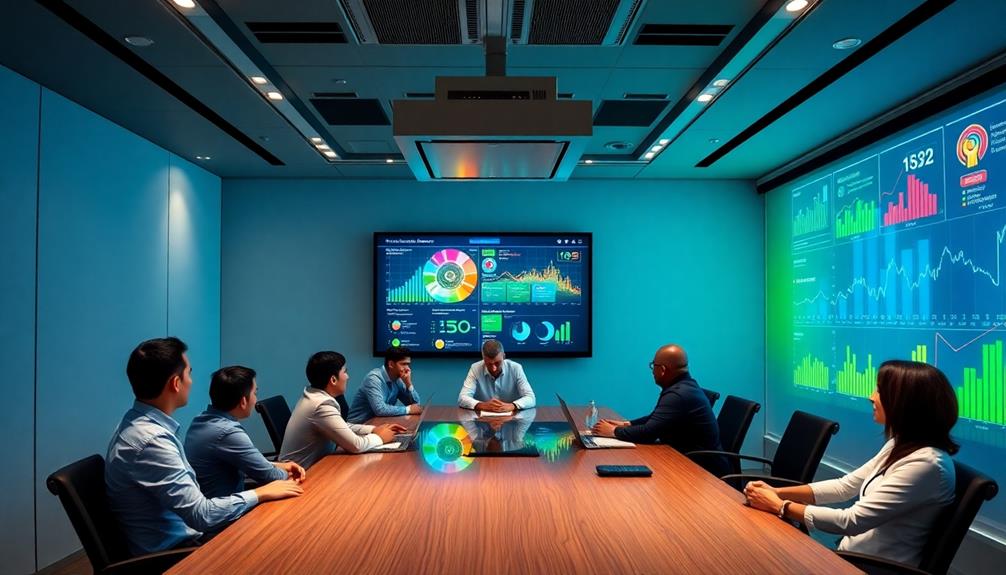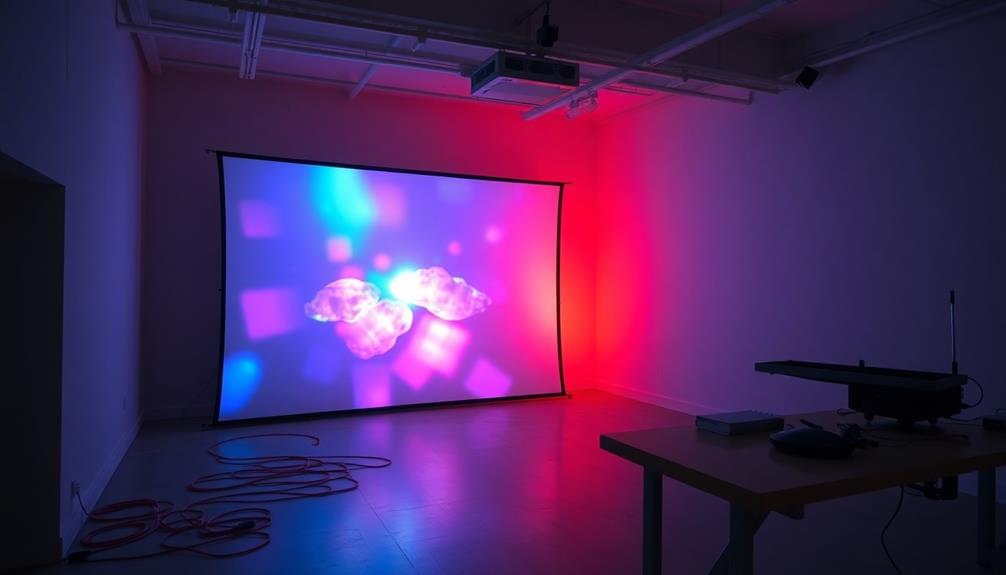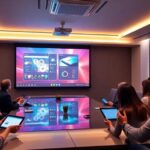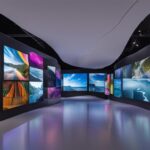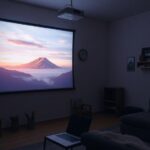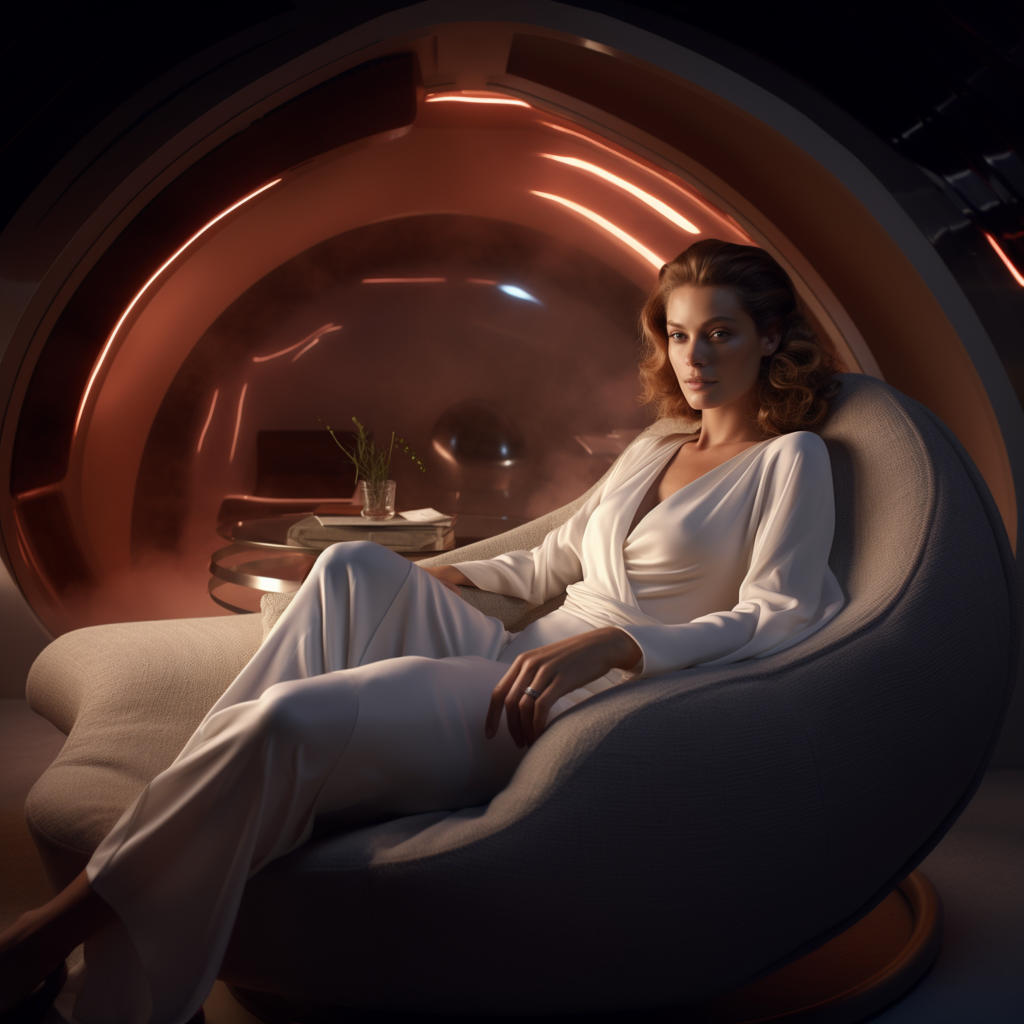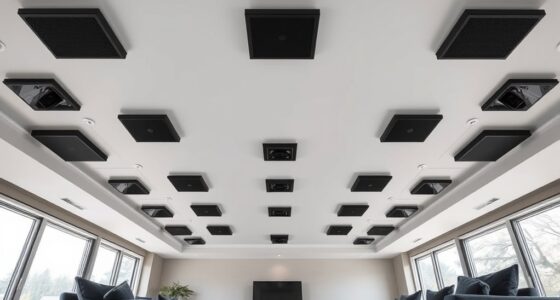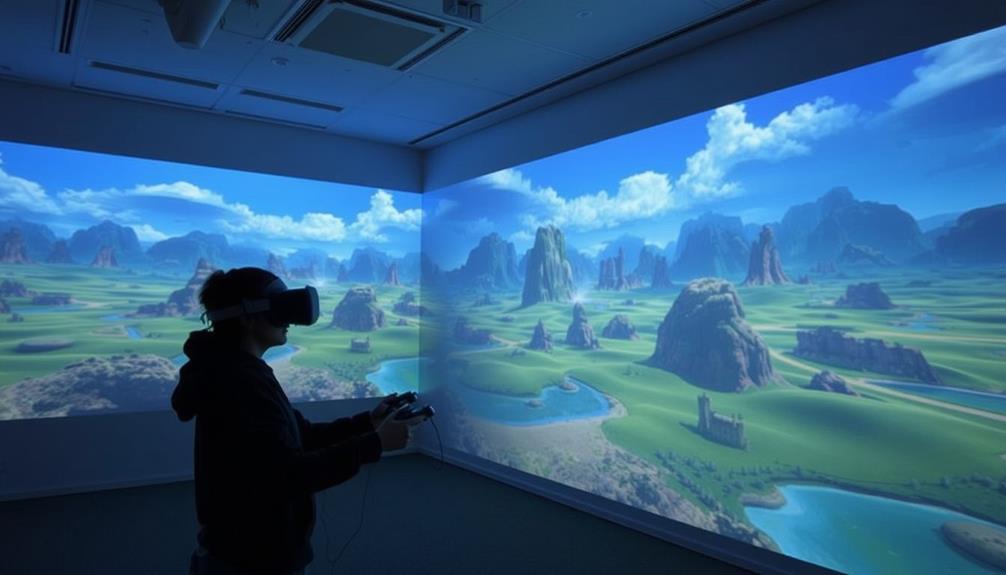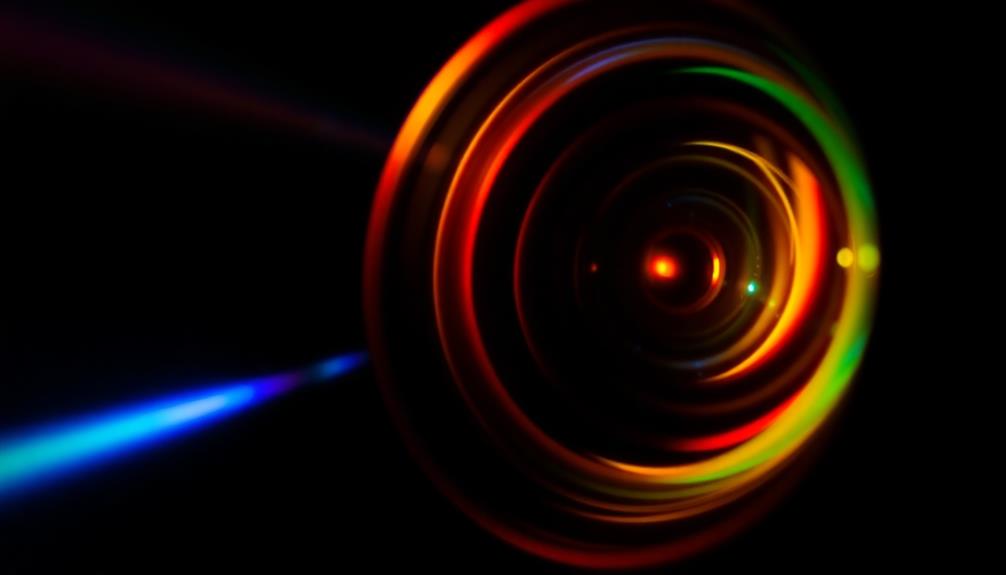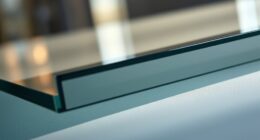Using a projector for digital signage can really elevate your business's visual communication. You can create eye-catching displays that capture customer attention in retail stores, corporate offices, and trade shows. Projectors let you easily update content in real time, helping keep your messaging fresh and relevant. They're also cost-effective, especially when you need to cover large areas. Ideal projectors typically have a resolution of 1920×1200 and brightness around 5,000 lumens. You'll find that these tools provide flexibility and adaptability for any environment. Keep exploring to discover specific projector models and installation tips tailored to your needs.
Key Takeaways
- Projection digital signage enhances customer engagement with dynamic visuals, making it ideal for retail, corporate, and event applications.
- High-quality projectors with recommended specifications ensure optimal performance in various lighting conditions for effective messaging.
- Cost-effective solutions allow businesses to cover large display areas without the high installation costs of traditional screens.
- Installation considerations like surface preparation and projector positioning are crucial for achieving clarity and visibility of projected content.
- Future trends include advancements in resolution, interactive features, and AI integration to create immersive and personalized viewer experiences.
What Is Projection Digital Signage?
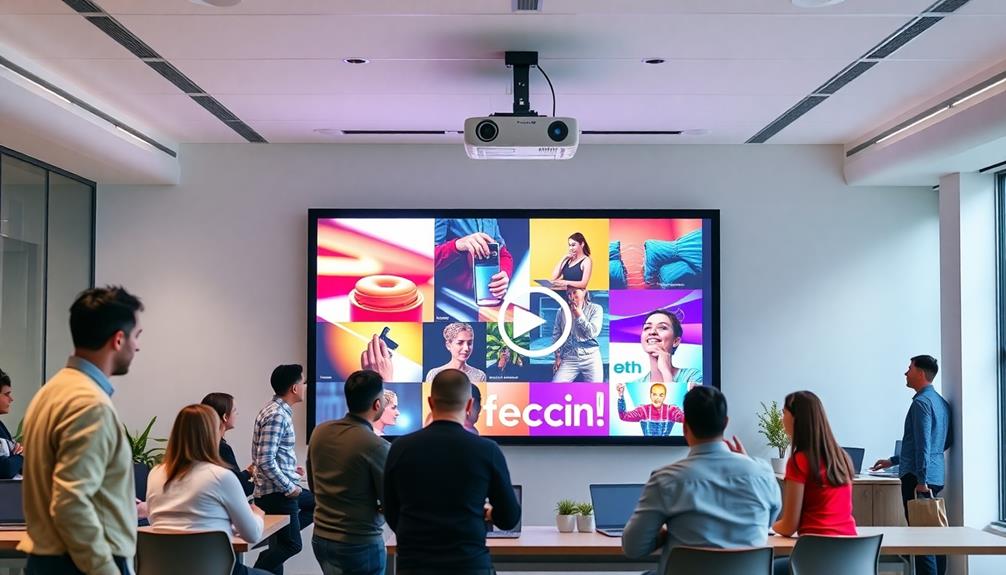
Projection digital signage uses projectors to display dynamic multimedia content on various surfaces like walls, floors, and ceilings. This technology is a versatile alternative to traditional signage, making it perfect for creating immersive experiences in retail spaces and other environments.
Digital signage projectors allow you to display content that captures attention, enhancing customer engagement through eye-catching visuals and interactive elements.
When considering projection digital signage, key technical aspects like resolution, brightness, and contrast ratio come into play. Brightness, measured in lumens, directly impacts visibility, especially in well-lit areas. A high contrast ratio guarantees that the images remain sharp and clear, even from a distance.
These factors greatly influence the effectiveness of your displays, so it's essential to choose the right projectors for your needs.
This technology is widely used across various applications, including corporate environments, museums, and events, providing cost-effective solutions for large display areas.
With content management software, you can easily update and customize your visuals, allowing for real-time changes to promotional messages and advertisements.
How Projection Digital Signage Works

Typically, projection digital signage operates by connecting high-quality projectors to computers or media devices, allowing you to display vibrant multimedia content on various surfaces like walls and floors. This digital signage solution leverages exceptional image quality, influenced by key technical factors such as resolution, brightness, and contrast ratio.
For instance, a resolution of 1920×1200 combined with a brightness of around 5,000 lumens is ideal for larger spaces, ensuring your content remains vivid and engaging.
Content management software plays a vital role, enabling you to easily update and customize displayed multimedia content. This flexibility enhances customer engagement, allowing you to deliver timely and relevant messages that resonate with your audience.
Installation logistics are equally important; projector positioning, mounting, and consideration of ambient light conditions can markedly affect visibility and image quality. By carefully planning these aspects, you can create immersive experiences that captivate your audience.
Additionally, incorporating interactive elements through software can further enhance customer interaction with projected content, making it a dynamic component of your business strategy.
Benefits of Using Projectors
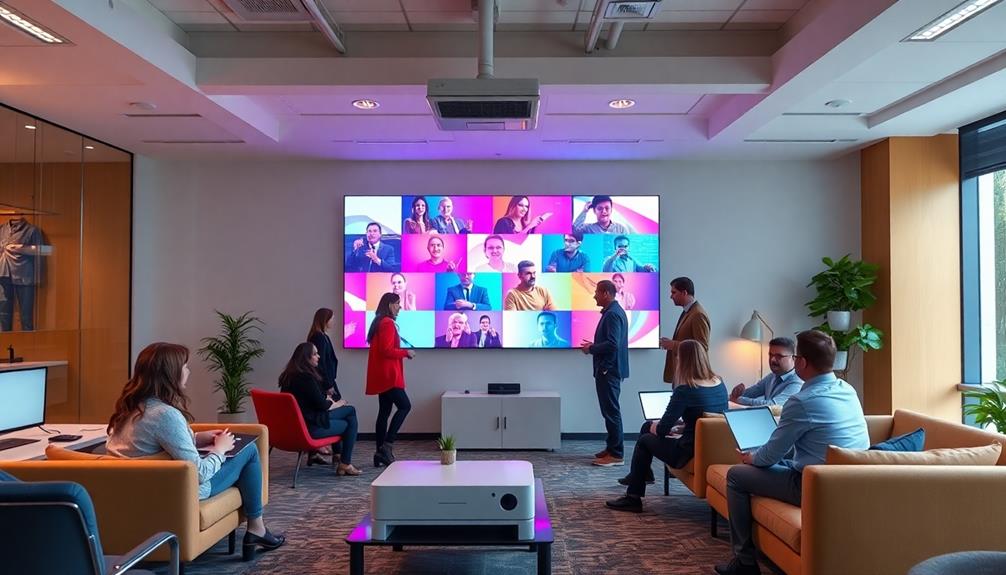
When you choose projectors for digital signage, you access a range of benefits that enhance your visual communication strategy. Projectors offer flexibility in content placement, allowing you to project onto any surface and create large images that captivate your audience. This flexibility means you can easily adapt to different environments, whether in retail, corporate settings, or museums.
High-quality projectors, like the Epson PowerLite L510U, deliver stunning visuals with 5,000 lumens brightness and a 2,500,000:1 contrast ratio, ensuring your displays remain clear and vibrant, even in brightly lit spaces. By utilizing projectors, you can create engaging and attention-grabbing displays that draw customers in and keep their focus.
Moreover, projectors are cost-effective solutions for large display areas, eliminating high installation costs associated with traditional screens. You can dynamically update your content with ease, allowing for fresh and relevant messaging.
When not in use, projectors can blend seamlessly into their surroundings, maintaining aesthetic appeal and providing a modern alternative to conventional signage methods.
To conclude, projectors enhance your digital signage strategy by creating immersive experiences that engage your audience effectively.
Ideal Business Applications

In a variety of business settings, projectors shine as versatile tools for enhancing customer engagement and communication. With advancements in technology, such as Apple's on-device AI privacy revolution, they cater to diverse digital signage needs, allowing you to create interactive and immersive visuals that captivate your audience.
Here are three ideal applications for projectors:
- Retail Stores: Use projectors to create dynamic advertising displays that attract customers' attention and promote special offers. This approach enhances the in-store shopping experience and boosts sales.
- Corporate Offices: In corporate environments, projectors are invaluable for displaying schedules, announcements, and engaging presentations. They foster better communication and information sharing among employees, making it easier to keep everyone informed.
- Trade Shows and Events: At trade shows, projectors help businesses stand out with eye-catching brand presentations and dynamic visuals. They effectively communicate your brand message, ensuring you're memorable in competitive environments.
Utilizing projectors in these settings not only elevates your visual presentation but also enriches the experience for your customers and employees alike.
Whether it's for large-scale displays or intimate settings, projectors can transform your approach to digital signage.
Recommended Projector Models

When you're choosing a projector for digital signage, you'll want to focus on key features like resolution and brightness.
Some models stand out for specific applications, making it easier for you to find the perfect fit for your needs.
Let's look at some top projector recommendations that can enhance your displays.
Key Features to Consider
Selecting the right projector for digital signage involves considering key features that guarantee peak performance and visual impact. To guarantee you choose a model that meets your needs, keep the following in mind:
- Brightness: Look for a projector with at least 3,000 lumens for larger areas. The Epson PowerLite L510U and Optoma ZU506T-W, both boasting 5,000 lumens, are excellent options for vibrant displays.
- Resolution: High resolution is essential for image quality. Aim for a minimum of 1920×1200 resolution to achieve clear and detailed visuals. Models like the BenQ MW855UST offer a balance of quality and affordability with 1280×800 resolution.
- Contrast Ratio: A high contrast ratio enhances color vibrancy and depth, creating an immersive experience for viewers. The Epson PowerLite L510U impressively features a contrast ratio of 2,500,000:1, guaranteeing dynamic displays that effectively communicate your information.
Top Projector Recommendations
Choosing the right projector for your digital signage can greatly enhance the visual experience and impact your audience. When considering projectors, you'll want to focus on models that meet your brightness requirements and resolution needs.
The Epson PowerLite L510U stands out with a high resolution of 1920×1200 and an impressive brightness of 5,000 lumens, perfect for environments demanding clear, vibrant displays.
If you're looking for versatility, the Optoma ZU506T-W also boasts 1920×1200 resolution and 5,000 lumens brightness, guaranteeing effective visibility in both bright and dark settings.
For smaller retail spaces or corporate offices, the BenQ MW855UST is an excellent choice, offering a resolution of 1280×800 and 3,500 lumens, making it ideal for short-throw installations.
Lastly, if you need something portable, the KODAK LUMA 450 is compact yet powerful, providing Full HD resolution and the ability to project a 150-inch screen, perfect for mobile presentations.
Application-Specific Choices
Finding the right projector for your specific application is essential for maximizing the impact of your digital signage.
With the right choice, you can create an immersive experience that captivates your audience.
Here are three recommended models tailored to various business needs:
- Epson PowerLite L510U: With a 1920×1200 resolution and 5,000 lumens brightness, this projector excels in well-lit environments, providing high-quality visual content that's clear and vibrant.
- Optoma ZU506T-W: Ideal for retail settings, this model also features 1920×1200 resolution and 5,000 lumens brightness, ensuring dynamic content delivery and engaging customer experiences.
- BenQ MW855UST: This short-throw projector offers 1280×800 resolution with 3,500 lumens brightness, perfect for smaller spaces where projection distance is limited, helping to avoid shadows.
Installation Considerations
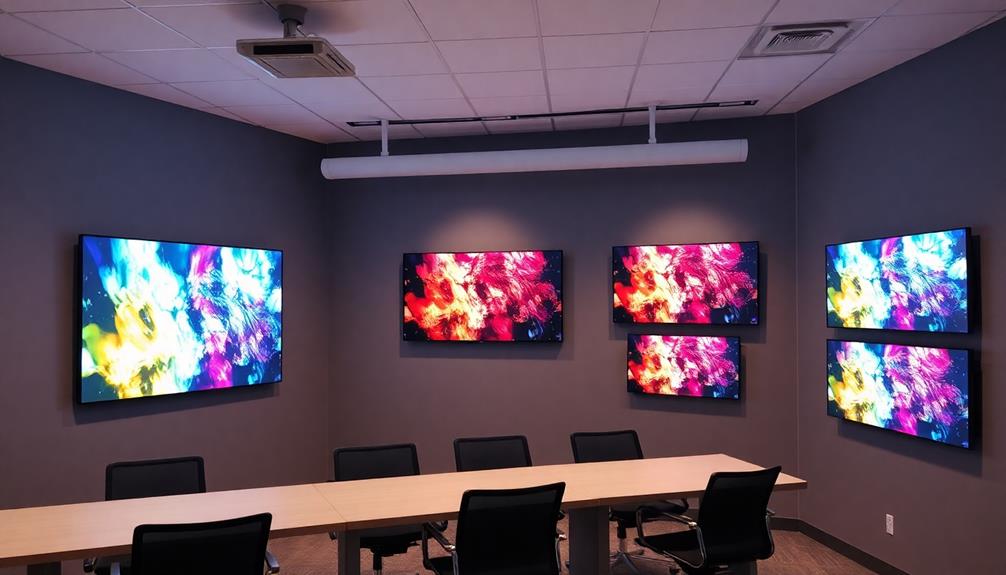
When you're setting up your projector for digital signage, think about the surface preparation and how you'll mount and position the device.
Proper surface quality guarantees the best image clarity, while strategic mounting can enhance visibility and reduce shadows.
Surface Preparation Techniques
For ideal image clarity and color accuracy, surface preparation is essential in digital signage installations. A well-prepared projection surface can make a significant difference in how your projected content is received.
Here are three key considerations to keep in mind:
- Surface Cleanliness: Confirm your surface is clean and free from dust or debris. Any imperfections can distort your image.
- Surface Texture: Opt for smooth, light-colored surfaces. These enhance brightness and contrast, minimizing light absorption and improving overall image quality.
- Angle and Alignment: Pay attention to the angle of your projection surface. Avoid keystone distortion by positioning your projector perpendicularly to the surface.
For outdoor installations, select weather-resistant materials that will endure varying environmental conditions.
Additionally, consider using specialized projection surfaces designed for ambient light rejection or high contrast to enhance your visual experience.
Proper surface preparation not only confirms peak image clarity but also creates an engaging viewing environment for your audience, making your digital signage truly effective.
Mounting and Positioning Strategies
Effective mounting and positioning strategies are essential for achieving peak performance in digital signage installations. Start by determining the proper mounting height, positioning the projector at or slightly above the top edge of the display surface. This minimizes distortion and maximizes visibility. If space is limited, consider using short throw projectors, which can project large images from close distances.
Calculate the projector's throw distance to guarantee the image fits your intended surface without sacrificing brightness and image clarity. Utilize adjustable mounts and lens shift features for precise positioning, allowing you to make minor adjustments without relocating the entire unit.
Finally, evaluate ambient light conditions during installation. Projectors thrive in controlled lighting environments, so you might need blackout shades or strategic surface placement to enhance image clarity and color accuracy.
| Strategy | Key Consideration | Recommended Action |
|---|---|---|
| Mounting Height | Position above display edge | Adjust for peak visibility |
| Throw Distance | Calculate based on model | Guarantee proper image fitting |
| Projector Type | Short throw for limited space | Choose based on environment |
| Positioning Features | Use lens shift for alignment | Facilitate minor adjustments |
| Light Control | Assess ambient conditions | Implement blackout solutions |
Future Trends in Projection Signage

As we look to the future, projection digital signage is set to evolve dramatically, driven by advancements in technology. You can expect to see several exciting trends shaping the landscape:
- 4K and Higher Resolutions: Enhanced visuals will grab your audience's attention like never before, with sharper images and more detail.
- Interactive Features: With augmented reality (AR) becoming mainstream, you'll create immersive experiences that allow users to engage directly with your content.
- Wireless Connectivity: Say goodbye to cumbersome setups! Streamlined content updates will make managing your digital signage networks a breeze, enabling real-time changes.
Moreover, projection mapping technology will enable you to transform ordinary surfaces into dynamic displays, enchanting viewers in innovative ways.
The integration of artificial intelligence (AI) will provide personalized content delivery, allowing you to tailor messages based on audience data and behaviors. This means your digital signage won't just inform; it will connect and resonate with viewers on a deeper level.
Embracing these trends will set you apart in a competitive market and enhance your business's communication strategy. Get ready to explore the future of projection signage!
Real-World Use Cases

Projectors have found a diverse range of applications across various industries, showcasing their versatility and impact. In retail, you can leverage projectors to create dynamic displays that engage customers with interactive promotions. This strategy notably boosts foot traffic and dwell time in your store, enhancing the overall customer experience.
Museums have also embraced projectors, utilizing them to showcase art dynamically through multimedia installations that enrich visitor experiences without altering the physical space.
If you run a restaurant, consider using projection mapping to create an immersive dining experience. By transforming tabletops or walls into engaging scenes—like underwater visuals—you can elevate customer enjoyment and satisfaction.
At trade shows, projectors play an essential role in engaging brand presentations, projecting 3D animations and vibrant visuals that stand out in crowded spaces.
Shopping malls, too, implement projectors for eye-catching seasonal displays and promotions, capturing the attention of passersby with visuals that can be updated in real-time, eliminating the need for physical signage changes.
With these real-world use cases, it's clear that projectors have a considerable impact on digital signage across various sectors.
Frequently Asked Questions
What Are Projectors Used for in Business?
In business, you use projectors for impactful presentations, dynamic advertising, and engaging internal communications. They enhance meetings, captivate customers in retail, and create immersive experiences in galleries, making your messages more memorable and effective.
What Is the Best Operating System for Digital Signage?
Did you know that 72% of consumers prefer digital signage over traditional advertising? When choosing the best operating system for your digital signage, consider Windows for compatibility, Android for cost-effectiveness, and Linux for stability and security.
What Device Is Used for Digital Signage?
For digital signage, you'll typically use screens, projectors, or digital displays. Each device has unique features that enhance visibility and engagement, so choose one based on your specific needs and environment.
Is Digital Signage Profitable?
Digital signage isn't just profitable; it's like finding a goldmine! You'll enjoy increased sales, improved customer recall, and reduced costs. With a growing market, you're set to reap substantial rewards by embracing this dynamic medium.
Conclusion
Incorporating projection digital signage into your business can transform how you engage with customers. You might worry about the initial setup or the cost, but the long-term benefits outweigh these concerns. With vibrant visuals and the flexibility to adapt your content quickly, you'll capture attention like never before. Plus, as technology advances, projectors are becoming more accessible and easier to install. Don't miss out on the opportunity to elevate your brand and enhance customer experiences with dynamic displays!
Hi, I’m Dominique. I love movies and want everyone to have the best home cinema experience possible. That’s why I started 1home Theatre Projector. We help people build their home cinema system using the latest technology and news on laser tv and all-around home entertainment.
We’re a small team of movie buffs (and experts) who are passionate about giving our readers the best advice and information possible. So whether you’re just starting out or you’re looking to upgrade your home cinema system, we’ve got you covered!
